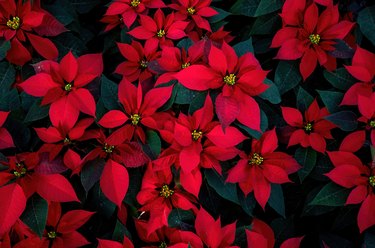
Each of us has a unique idea of what makes the holiday season "really feel like the holidays." It might be seasonal songs played in stores, the scent of baked goods in the oven, glittering decorations or eggnog and mulled wine shared with loved ones. For many, plants also play a significant role in setting the seasonal scene: Poinsettias, holly and—of course—Christmas trees are among the best-known.
We've got tips and tricks for keeping these plants (and a few extras) looking their best throughout the holiday season. If you handle them with care, some can bloom again or serve as year-round houseplants. Here's what you need to know about caring for your favorite holiday plants.
Video of the Day
Video of the Day
1. The Poinsettia
With the exception of your actual Christmas tree, the poinsettia (Euphorbia pulcherrima) is arguably the most iconic plant of the holidays. Its lush red and dark green hues mix perfectly with traditional holiday colors, though breeders have succeeded in producing well over 100 alternative colors too. The plant is native to Mexico, but it's now well established around much of the world as a seasonal plant.
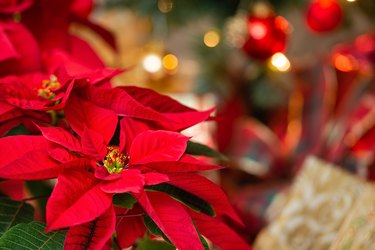
Plant Fact
The “blossom” of the poinsettia isn’t made of flower petals at all, but specialized leaves called bracts. The actual blossoms are a tight cluster of small buds and yellow flowers, right in the middle.
Tip #1: Poinsettia care during the holidays
Your poinsettia doesn't need much hands-on care for the few weeks of the holiday season. First and foremost, give it lots of sunlight and warmth. (It's semi-tropical, remember.) Keep it away from doors, radiators or anywhere else it might be exposed to cold drafts or rapid temperature changes. A sunny window that stays closed in winter is ideal. Poinsettia plants need light but consistent watering; every two to three days is a good rule of thumb, depending on the potting mix and the size of your pot. When in doubt, stick a finger into the soil. If it's dry at a depth of an inch or so (your finger to the first knuckle), it probably needs a drink. Excess water can cause the roots to rot.
Don't worry about feeding your poinsettia during this time. Nurseries use fertilized potting soil for the plants, so they'll be fine for a few weeks over the holidays.
Tip #2: Poinsettia care after the holidays
If you opt to keep your poinsettia as a houseplant into the new year, it's more or less business as usual. Water it lightly but consistently, and add in a weekly feeding with liquid houseplant fertilizer. After a few months (typically in late March or April), the leaves' colors will fade and start to look bedraggled. At this point, you can either discard the plant or keep it alive until next year's holidays. Bear in mind that although it will come back, your plant will never give you as lavish a display as you saw the first time. Think of it as an exercise for your gardening skills, perhaps.
To keep your poinsettia alive, prune it back to about 4 inches high and move it from its bright, sunlit window to a cooler, shadier spot. Water about half as often as you did during the holidays (maybe every 5 to 7 days). Repot it in a month (or whenever you start to see new growth), but keep it in a cooler spot until fall—65 to 70°F is ideal.
Come November, it's time to "force" the plant to regrow its colorful bracts. Start by giving it 12 hours of bright sunlight followed by 12 hours of darkness each day. By the time the holidays are in full swing, the plant should have regained its bright hues. If you prefer, you can skip the "forcing" and simply keep your poinsettia as a pretty year-round houseplant—but you'll need to give it that same pruning and period of dormancy each year to keep it healthy and thriving.
2. The Christmas Cactus
Another iconic holiday plant is the Christmas cactus or Thanksgiving cactus—names given to closely related succulents in the Schlumbergera family. They push out their bold, dramatic blossoms during the holiday season (typically from November to January) and continue to grow in a leisurely fashion throughout the rest of the year.
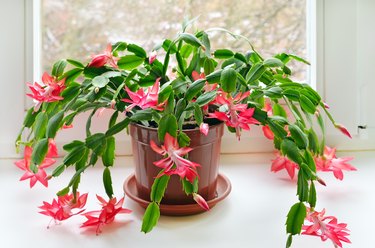
Tip #1: Christmas cactus care during the holidays
Your Christmas cactus is native to the rain forest, so it needs indirect light rather than bright sunshine. An east-facing window is ideal. It likes lots of humidity but not wet soil, so plan to water it every two to three weeks or whenever the soil is dry—overwatering will cause root rot and kill your plant. Misting the soil and plant regularly will help keep it (and its blooms) healthy if your indoor air is dry. Fertilize once a month while they're blooming, which of course is the entire holiday season. That's really all the plant needs, except for being placed out of the reach of rowdy preschoolers or rambunctious pets.
Tip #2: Christmas cactus care after the holidays
After your cactus has blossomed, it's ready for a bit of downtime and recuperation—guess we're not the only ones who feel exhausted after the holiday season! If it's looking tired, or if you can see roots coming out of the drainage holes at the bottom of the pot, you should move the cactus to a slightly larger container filled with a potting mix that's meant for succulents (in other words, with light, well-drained soil). Water the plant and put it in a shady spot for a few days after repotting, so it has time to recover.
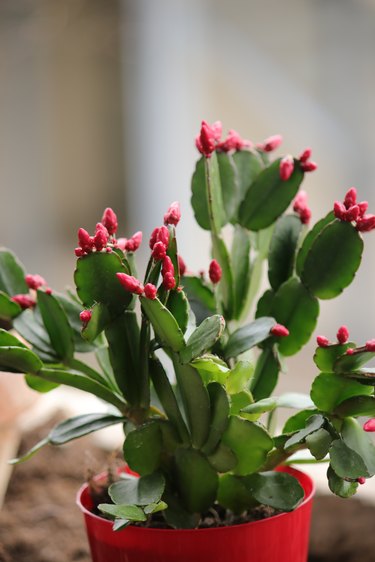
Once the plant perks up, late spring is a good time to prune it. Cut the last section or two from a few of the branches, and—hydra fashion—two branches will grow back where there was one before. Over time, this steadily makes your cactus larger and more dramatic. You can root the trimmings as well and with proper care, they'll grow into new, healthy plants that make great gifts.
Feed the cactus with a houseplant fertilizer every couple of weeks throughout the spring and summer, and keep it someplace humid where the temperatures will consistently hover in the high 60s or low 70s°F. To trigger a fresh round of blossoms the following year, give the plant 12 hours of complete darkness each day (think: putting it in a closet or covering it with a bag). After a few weeks, you'll start to see small buds forming. This is the sign of success! Bring the plant back out into the light and provide it with a high-potassium fertilizer every couple of weeks until blossoming begins.
3. The Fresh Christmas Tree
Artificial Christmas trees may be convenient, but they can't offer the fresh forest scent of a natural tree. There's a genuine debate over which is better: a live tree to enjoy for a few weeks versus a long-lasting artificial version made of materials that aren't sustainable.
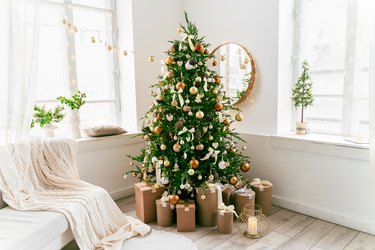
If you decide to go the natural tree route, how do you find a Christmas tree that actually lasts? Buy the freshest tree you can find, which will usually come from a local supplier, as opposed to a big garden center. Mass-market trees are harvested weeks ahead of time to allow for shipping, while a locally grown tree might be cut as early as that morning.
How to tell if a Christmas tree is fresh
A good test is to gently run your hand along a few branches of a natural Christmas tree. If the needles are soft and pliant and stay on the tree, it’s nice and fresh. If they feel dry in your hand and fall off the tree readily, move along and try another seller.
Tip #1: Christmas tree care during the holidays
Your biggest concern with any live tree is keeping it from drying out. Start by cutting at least an inch from the bottom of its trunk (or having the seller do it for you). Trees, like humans, automatically begin trying to heal any wound sustained. A fresh-cut trunk is better at absorbing the water your tree will need to remain healthy. A good rule of thumb is that your stand should hold a quart of water for each inch of the tree's diameter, which usually equates to at least a gallon. Check and refill it often, as a tree can easily go through a gallon or more of water in 24 hours.
The firs and pines most commonly used as Christmas trees don't care for hot conditions, so keep them in a cool corner of your room and away from any heat sources. If your indoor air is dry during the winter months, it's also a good idea to mist the tree regularly or set up a humidifier in the room.
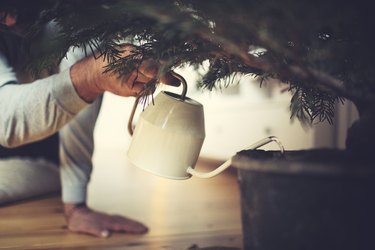
Tip #2: Christmas tree care after the holidays
Natural trees last only three to five weeks after they're cut, so after-holiday care consists mostly of deciding which day you'll take the tree down—leaving it up from Thanksgiving to mid-January (or, for some who just can't let go of the holidays, well into the spring months) is a luxury you'll have only with an artificial tree. Many municipalities offer designated pickup dates for trees, but you can also arrange to have it chipped or cut it up for next winter's firewood. Want to give back to nature? You can even turn your discarded tree into an eco-conscious bird feeder by leaving it in the backyard after coating it with peanut butter, dried fruit, bird seed and other treats that will appeal to feathered friends.
One way to reuse the same tree year after year is to buy a potted Norfolk pine, a semitropical species that works well as an indoor houseplant. It needs full sun and a soil that's light, well-drained and slightly acidic. Norfolk pines also like a lot of humidity, so you'll need to mist them regularly if you live in an arid climate. They appreciate diluted liquid fertilizer every few weeks through the sunny parts of the year, but during winter months—or times of low light for any other reason—you should stop fertilizing lest the tree show unsustainable, "leggy" growth.
4. The Amaryllis and Paperwhite Narcissus
These popular indoor blossoms aren't the most common plant for seasonal decor, though they're popular as "hostess gifts" over the holidays or as a way to brighten (and, in the narcissus' case, scent) an indoor space. The amaryllis' large, boldly colored blooms and the narcissus' smaller, snowy-white blossoms each provide a charming complement to the rest of your space.

Tip #1: Amaryllis or narcissus care during the holidays
Neither of these plants requires a whole lot of "care and feeding" during the holidays because the bulbs themselves contain all the nourishment they'll need—after all, that's what bulbs are for. Amaryllis plants like a lot of indirect sunlight and need minimal care other than regular watering. Once the blooms emerge, you might even want to snip them off and place them in a vase as cut flowers for a longer lifespan.
Paperwhite narcissus, on the other hand, prefer direct sunlight, but once the blossoms emerge, they'll last longer in indirect light (and less of it) and a cooler placement. Temperatures in the 50s to 60s°F are ideal, but that's often hard to arrange indoors in your main living area. Most of us will cheerfully accept less blossoming time in exchange for our own comfort.

Tip #2: Amaryllis and narcissus care after the holidays
After they've finished blossoming, narcissus are simply done. You can discard the bulbs with a clear conscience and forget about them. Amaryllis, on the other hand, can be preserved and blossom again year after year. So if you want to enjoy those colorful blossoms next Christmas, it's absolutely possible.
Start by cutting the stem back to about 1 inch above the bulb once the plant has finished blossoming. Keep watering and feeding it every few weeks with a balanced liquid fertilizer. New green leaves will grow and start the important work of photosynthesizing to replenish the bulb for its next round of blossoms. Then, around August, stop watering the plant and let its foliage wither and die away. Once it has completely dried out, store the bulb in a cool, dry, dark spot for a minimum of eight weeks (longer is fine, too). The bulb needs that period of dormancy in order to blossom.
Six to eight weeks before you want it to start blossoming (late October or early November for mid-December blooms), plant the dry bulb in fresh soil, place it in an area with lots of indirect light and begin watering it—sparingly at first—until you begin to see new growth. Begin watering regularly again, frequently enough to keep the soil moist but not wet. Fresh blossoms will happen in due course.
Plant Fact
With proper care, an amaryllis can last for years or even decades!
5. The Holly Sprig and Shrub
Holly (various members of the Ilex family, but usually Ilex aquifolium) is right up there with poinsettias and Christmas trees as one of the most iconic seasonal plants. Its tough, dark green foliage and bright red berries are a staple of holiday decor—and deservedly so. There are two ways you can incorporate holly into your decorating scheme: through cut sprigs or a live shrub in a large pot.
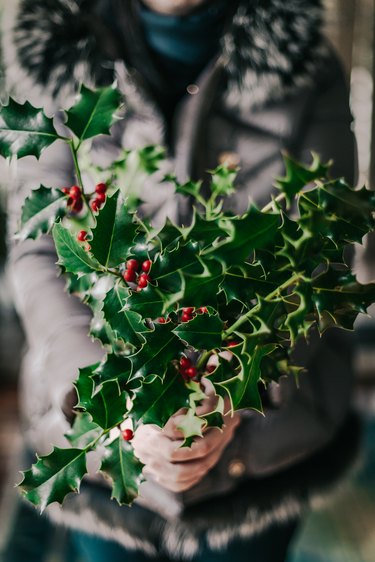
Tip #1: Holly care during the holidays
Cut holly will keep best if it's arranged in a vase, just like cut flowers. Simply change the water frequently enough to keep it fresh. Swags and wreaths made of holly are usually used as outdoor decorations, so watering them isn't really an option, but the cool weather will keep them intact. In places like windowsills and shelves, where you'll want to lay the holly horizontally, mist the sprigs daily to guarantee freshness. Avoid placing them in warm places or near heat sources. (Sadly, a big arrangement of holly above a well-used fireplace mantel is a bad idea.)
Tip #2: Holly care after the holidays
Owning a live holly shrub in its own pot will give you year-round enjoyment with its distinctive foliage. The vivid red berries are trickier: Only female plants produce them, but you'll need a male for pollination. Also, since insects won't do the work for you indoors, you'll need to manually take pollen from the male plant's to the female plant's blossoms with a fine paintbrush for the shrub to produce fruit. Aside from that, they're a remarkably low-maintenance plant. An established holly needs to be watered only every week or two and fertilized once a year due to slow growth. Give your holly shrub indirect light with partial shade and it will last for years.
6. The Christmas Rose
First things first: the so-called "Christmas rose," Helleborus niger, isn't part of the rose family at all. In fact, it's a distant cousin of the buttercup, native to central and southern Europe. The flower will grow—and blossom—outdoors during wintertime in much of the United States. It's not particularly rose-like, but that's a minor quibble. As one of the few plants that blossoms naturally this time of year (amaryllis and narcissus must be tricked or "forced" to bloom in mid-winter), it's an obvious way to incorporate beautiful blooms in your holiday decor.
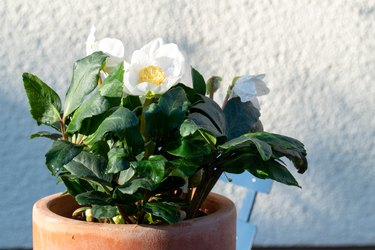
Tip #1: Christmas rose care during the holidays
The problem with using winter-blooming flowers for indoor decor is that they're hard-wired to expect cold weather during their blossoming cycle. They need the coolest (but still well lit) place you can give them. In practical terms, your best bet is to keep them in an unheated mud room, porch, shed or garage most of the time and bring them indoors when company's coming. They need richer soil than the potted plants we've talked about so far, so you'll need to be careful about overwatering. Let the surface of the soil dry a bit between waterings—though not for so long that the plant starts wilting. You'll get a feel for the correct interval after a couple of weeks.
Tip #2: Christmas Rose care after the holidays
Once the holidays are over, the best thing you can do for your Christmas rose is to stop bringing it into the house. If you live in an area where the ground doesn't freeze, you can "harden" the plant over a period of weeks by leaving it outdoors for increasingly long stretches and transplanting it into your garden. If you're in an area that's still within the plant's range (ask your local garden center or extension service) but where the ground does freeze, keep it in the coolest indoor spot you can find until spring. Then you can begin hardening it and move it into a permanent bed, as you would with any other spring transplant.
May your season—and your holiday plants—be merry and bright!